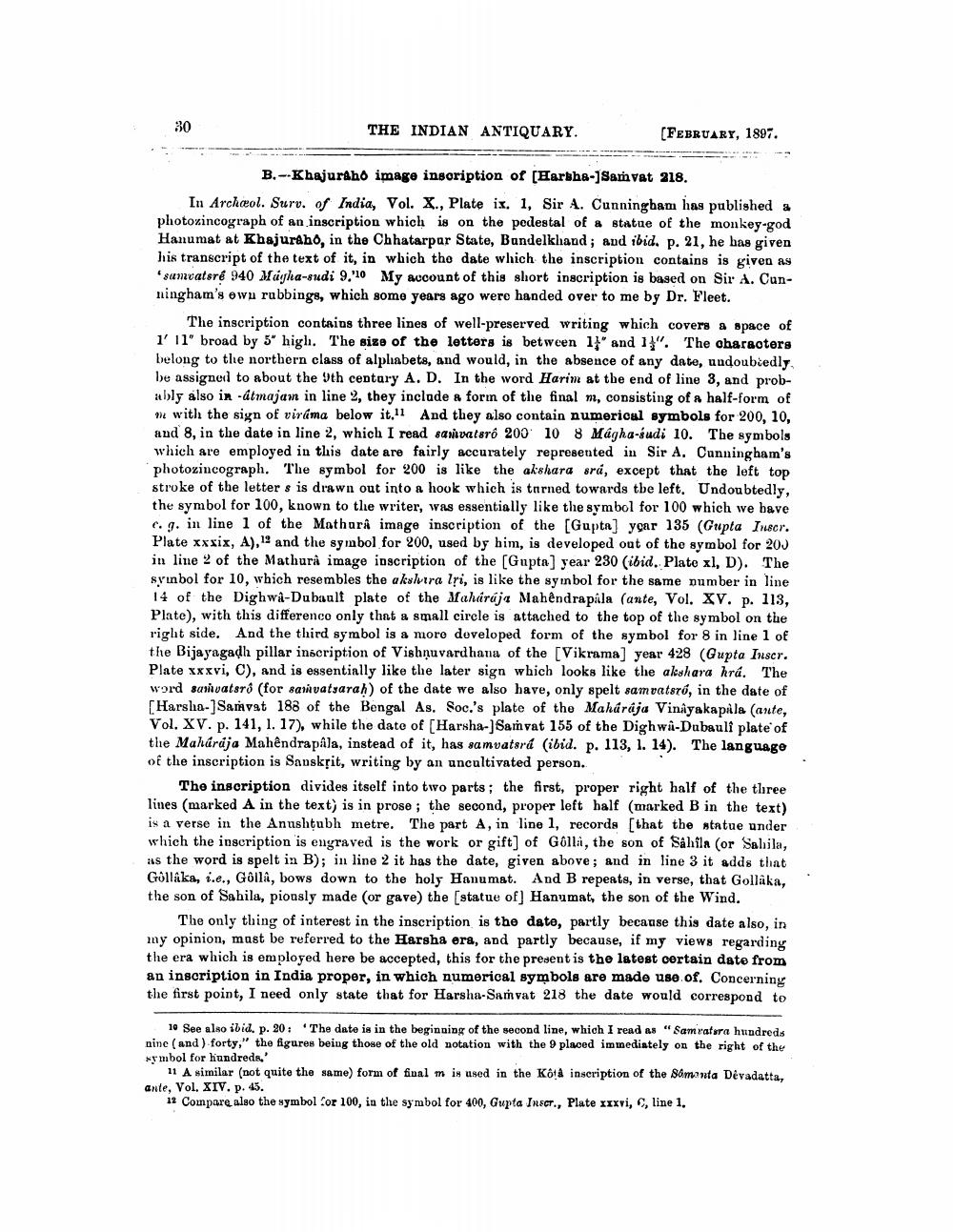________________
THE INDIAN ANTIQUARY.
(FEBRUARY, 1897.
B.--Khajuraho image inscription of (Harbha-)Samvat 218. In Archeol. Surv. of India, Vol. X., Plate ix, 1, Sir A. Cunningham has published a photozincograph of an inscription which is on the pedestal of a statue of the monkey-god Hanumat at Khajuraho, in the Chhatarpar State, Bundelkhand; and ibid. p. 21, he has given his transcript of the text of it, in which the date which the inscription contains is given as
sumcatsrê 940 Magha-sudi 9.'10 My account of this short inscription is based on Sir A. Cunningham's own rubbings, which some years ago were handed over to me by Dr. Fleet.
The inscription contains three lines of well-preserved writing which covers a space of 1' 11" broad by 5 high. The size of the letters is between 1 and 11". The characters belong to the northern class of alphabets, and would, in the absence of any date, undoubčedly be assigned to about the 9th century A. D. In the word Harim at the end of line 3, and probably also in -atmajam in line 2, they include a form of the final m, consisting of a half-form of me with the sign of virama below it.11 And they also contain numerical symbols for 200, 10, and 8, in the date in line 2, which I read sasivatsrô 200 108 Mágha-sudi 10. The symbols which are employed in this date are fairly accurately represented in Sir A. Cunningham's photozincograph. The symbol for 200 is like the akshara srá, except that the left top stroke of the letter s is drawn out into a hook which is turned towards tbe left. Undoubtedly, the symbol for 100, known to the writer, was essentially like the symbol for 100 which we have c.g. in line 1 of the Mathura image inscription of the [Gupta] year 135 (Gupta Inscr. Plate xxxix, A), and the symbol for 200, used by him, is developed out of the symbol for 200 in line 2 of the Mathurâ image inscription of the [Gupta) year 230 (ibid. Plate xl, D). The syinbol for 10, which resembles the akslurra lri, is like the syin bol for the same number in line 14 of the Dighwa-Dubault plate of the Maharaja Mahendrapala (ante, Vol. XV. p. 113, Plate), with this differenco only that a small circle is attached to the top of the symbol on the right side. And the third symbol is a more developed form of the symbol for 8 in line 1 of the Bijayagadh pillar inscription of Vishnuvardhana of the (Vikrama) year 428 (Gupta Inscr. Plate xxxvi, C), and is essentially like the later sign which looks like the akshara hrá. The word sasivatsrő (for samvatsarah) of the date we also have, only spelt samvatsró, in the date of [Harsha-]Samvat 188 of the Bengal As. Soc.'s plate of the Mahárája Vinayakapila (ante, Vol. XV. p. 141, 1. 17), while the date of (Harsha-]Samvat 155 of the Dighwa-Dubaulî plate of the Maharaja Mahêndrapala, instead of it, has samvatsrá (ibid. p. 113, 1. 14). The language of the inscription is Sansksit, writing by an uncultivated person.
The inscription divides itself into two parts; the first, proper right half of the three lines (marked A in the text) is in prose; the second, proper left half (marked B in the text) is a verse in the Anushtubh metre. The part A, in line 1, records [that the statue under which the inscription is engraved is the work or gift] of Golla, the son of Sahila (or Salila, is the word is spelt in B); in line 2 it has the date, given above; and in line 3 it adds that Gollaka, i.e., Golla, bows down to the holy Hanumat. And B repeats, in verse, that Gollaka, the son of Sahila, piously made (or gave) the (statue of] Hanumat, the son of the Wind.
The only thing of interest in the inscription is the date, partly because this date also, in my opinion, mast be referred to the Harsha era, and partly because, if my views regarding the era which is employed here be accepted, this for the present is the latest certain date from an inscription in India proper, in which numerical symbols are made use of. Concerning the first point, I need only state that for Harsha-Samvat 218 the date would correspond to
10 See also ibid. p. 20: The date is in the beginning of the second line, which I read as "Samratsra hundreds nine (and) forty," the figures being those of the old notation with the 9 placed immediately on the right of the Nymbol for hundreds.'
11 A similar (not quite the same) form of final m is used in the Koa inscription of the Samanta Devadatta. ante, Vol. XIV. p. 45.
11 Compare also the symbol Cor 100, in the symbol for 400, Gupta Inscr., Plate XIXvi, line 1.




